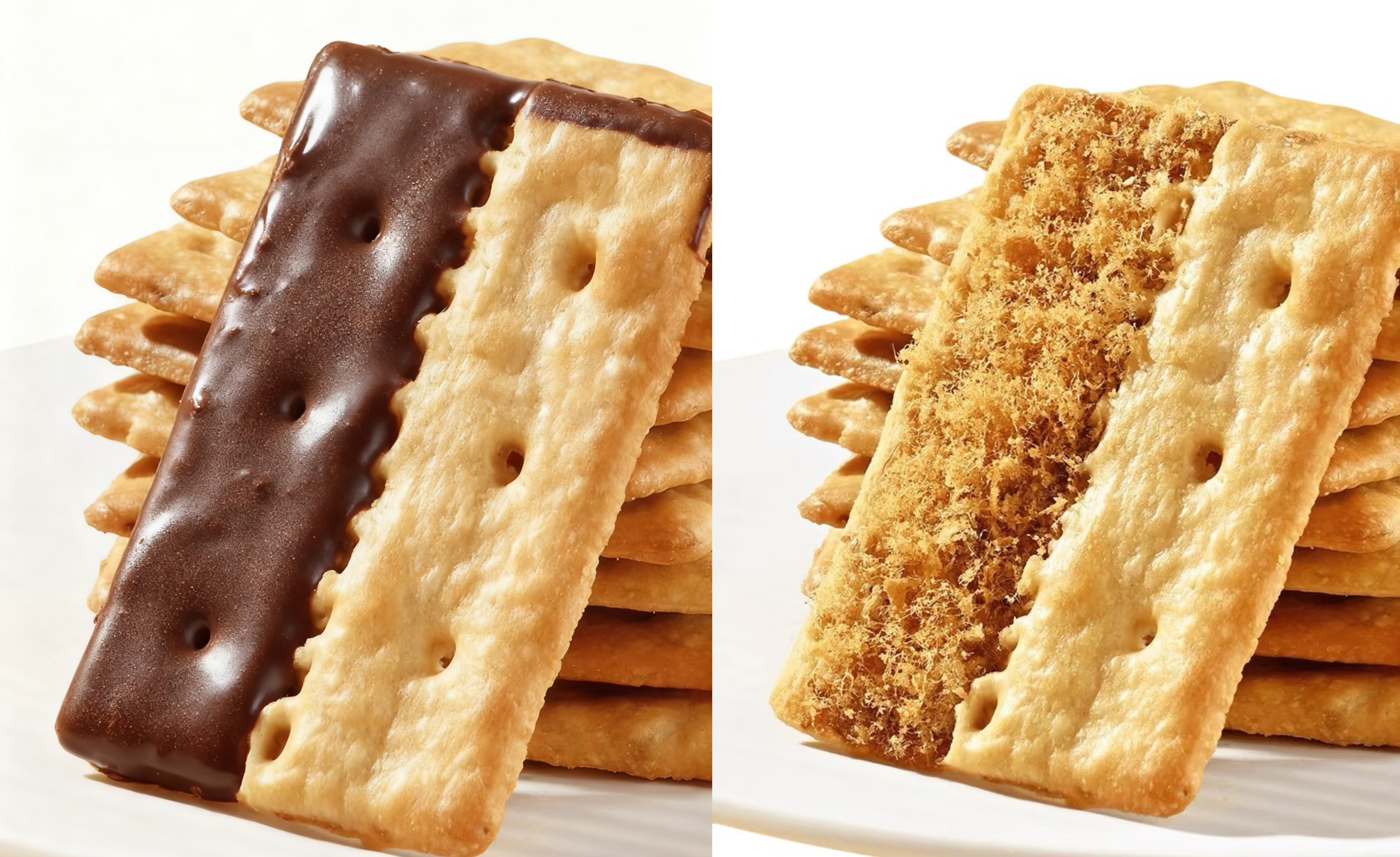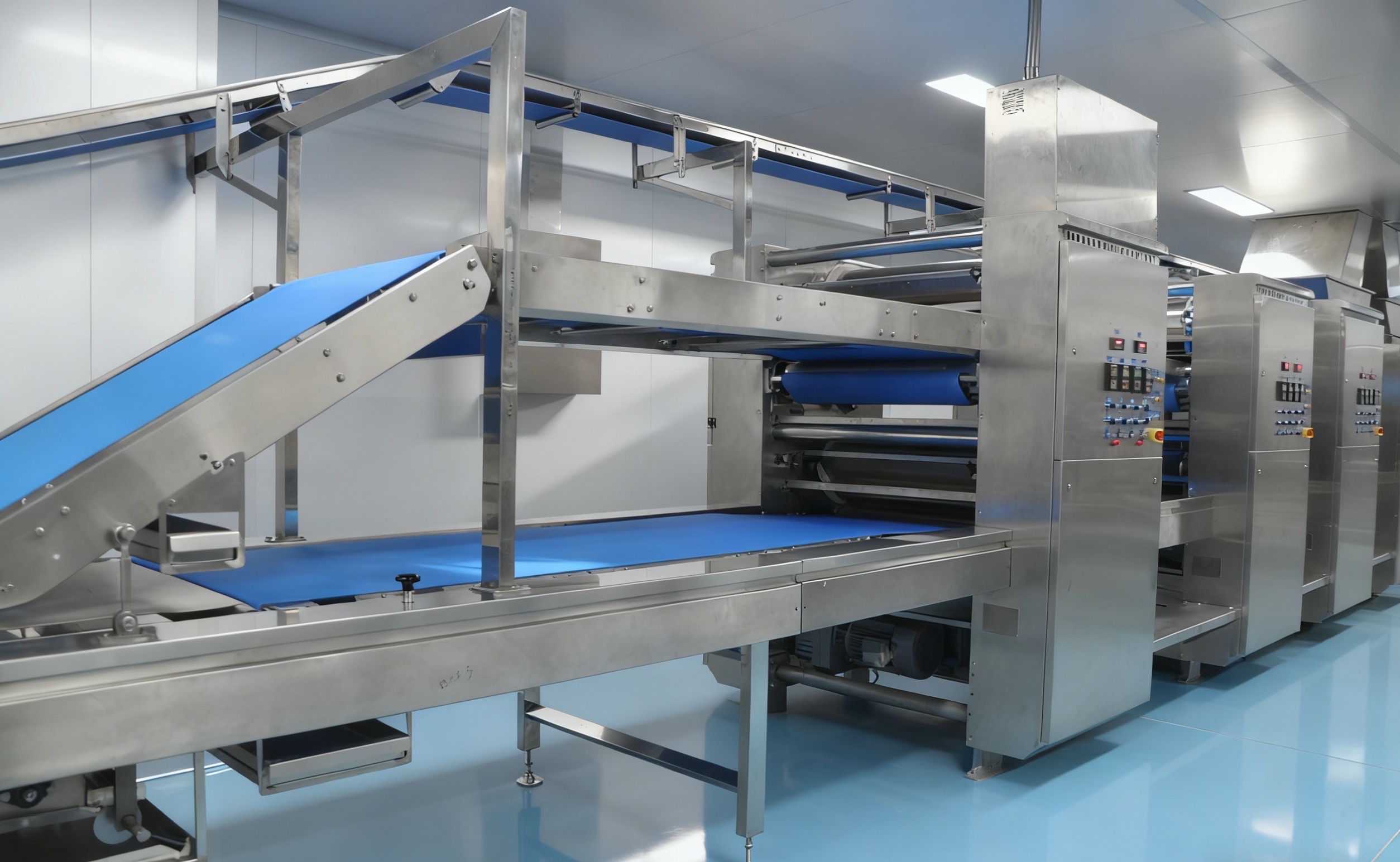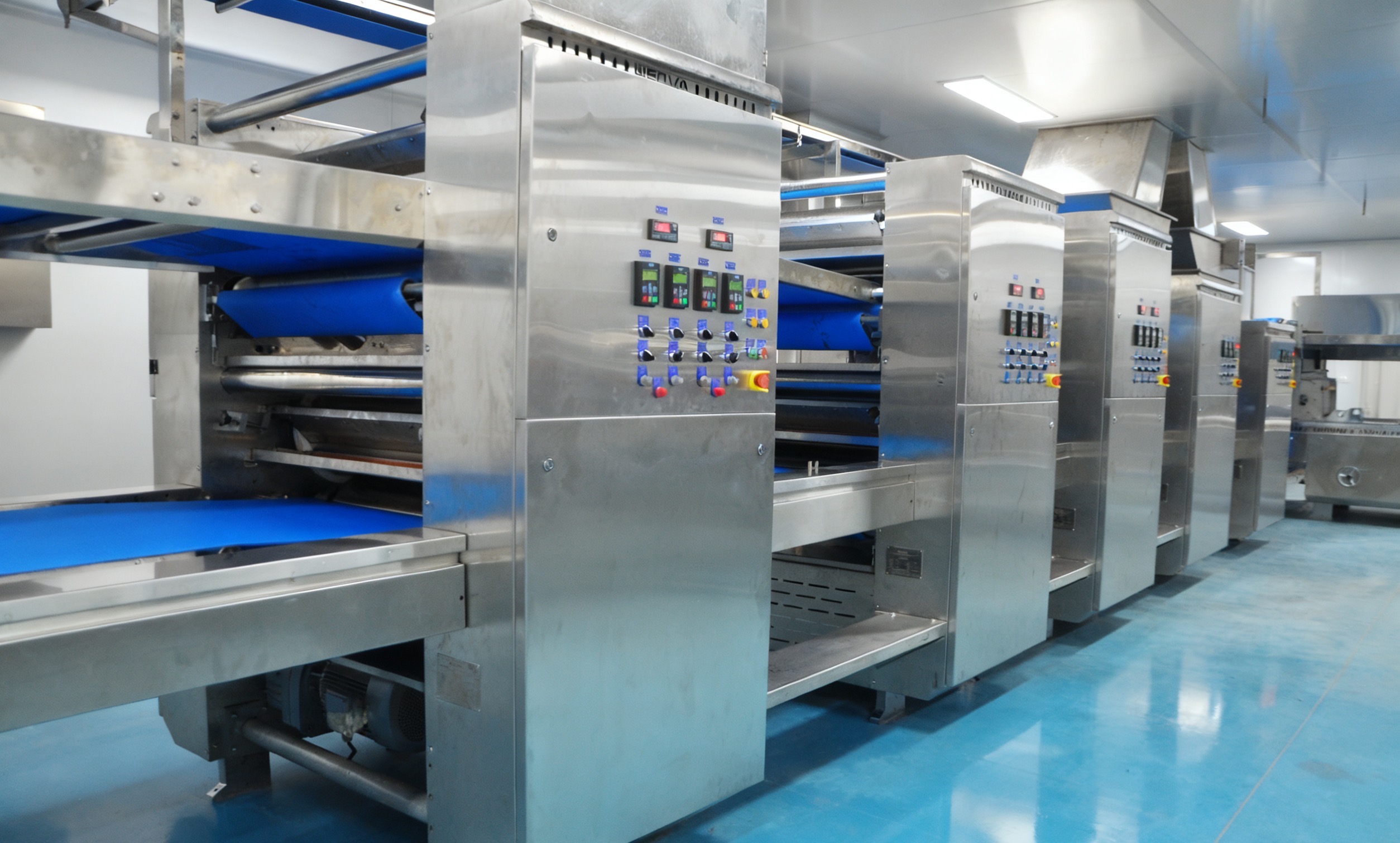Views: 0 Author: WENVA machine Publish Time: 2025-11-14 Origin: Site











Content Menu
● Understanding the Requirements of Double-Layer Biscuit Production
>> Why Double-Layer Production Requires Major Adjustments
● Step 1 — Assess Your Existing Single-Line Factory
● Step 2 — Identify Upgrade Requirements and New Equipment
>> Equipment That Must Be Added
>> Equipment That Can Usually Be Reused
● Step 3 — Designing the Layout of a Double-Layer Production Line
>>> Parallel Layout
>>> L-Shaped Layout
● Step 4 — Implementing the Lamination and Bonding Process
>> Critical Parameters to Control
● Step 5 — Adjust the Forming and Cutting Process
>> Forming Technologies That Work Well
● Step 6 — Recalibrate Tunnel Oven Settings
>> Why Baking Must Be Adjusted
● Step 7 — Update Cooling, Handling, and Packaging
● Step 8 — Conduct Testing, Calibration, and Quality Validation
● Step 9 — Train Operators and Engineers
● Cost Planning and Investment Outlook
● FAQ
>> 1. Can any factory upgrade to a double-layer biscuit line?
>> 2. Must the two dough layers use different recipes?
>> 3. Does double-layer production slow the line?
>> 4. What is the most common technical failure?
>> 5. Does the tunnel oven need to be replaced?
Transforming a traditional single-line biscuit factory into a high-performance double-layered biscuit production line is an excellent opportunity to expand your product portfolio, increase market competitiveness, and modernize aging facilities. Double-layer biscuits—whether laminated, composite, or texturally contrasted—require different engineering principles compared to conventional single-sheet biscuits. This guide provides a complete, practical roadmap for factories planning such an upgrade, covering equipment assessment, layout redesign, lamination technology, baking adjustments, staff training, and quality control.
Double-layer biscuits are composed of two dough sheets combined before forming or baking. The two layers may have:
Different formulations
Different dough textures
Different thicknesses
A bonding agent or mechanical compression

Two dough production streams must be synchronized
Laminating requires precise pressure and alignment
Baking performance changes due to different moisture and density
Cutting dies must accommodate multi-layer thickness
Cooling must be more controlled to avoid separation
Upgrading an existing line involves adapting every major processing stage.

Before purchasing equipment or redesigning layouts, conduct a comprehensive audit of the current production line.
Dough mixers and feeders
Sheeting/rolling units
Existing forming section
Tunnel oven length, heating zones, and control performance
Conveyors and cooling lines
Packing systems
Available floor space
Electrical and gas infrastructure
Understanding what can be reused and what must be replaced saves time and investment.
A double-layer system requires two dough-sheeting systems and a reliable lamination station.
1. Second dough sheeting line
Independent rollers
Gearbox-driven thickness controls
Separate dough feeder
Tailored dough handling depending on texture
2. Laminating and bonding station
Compression rollers
Alignment sensors
Water mist, slurry, or fat coating applicator
3. Synchronization control system
Ensures equal belt speed
Prevents wrinkling or drifting
Mixers
Ingredient dosing systems
Tunnel oven (if wide and flexible enough)
Cooling conveyors
Metal detector
Packagers (depending on biscuit height changes)
Upgrading to double-layer biscuits often requires redesigning the physical layout.
Two dough-sheeting lines placed side-by-side merging into one laminated sheet.
One sheeter placed above the other; the top sheet drops onto the bottom one.
Saves floor space but requires structural reinforcement.
Suited for factories with irregular floor plans.

This is the core of the upgrade. Lamination must produce a consistent, stable, two-layer dough sheet.
Mechanical compression using rollers
Water mist adhesion
Starch slurry or sugar solution coating
Oil/fat-based bonding
Top and bottom sheet thickness
Sheet speed synchronization
Bonding pressure
Adhesive dosage
Double-layer dough behaves differently from single-layer dough during cutting.
Rotary cutting for uniform shapes
Punch-and-cut for thicker laminated dough
Wire-cut (if top dough layer is softer)
Uniformity is crucial for preventing separation during baking.
Double-layer dough requires different thermal profiles.
Upper and lower layers expand at different rates
Moisture reduction must be even
If heat balance is incorrect, layers can separate
Modify top vs. bottom heat ratio
Lower initial zone temperature
Increase drying zones
Adjust conveyor speed for optimal moisture release
Cooling is more delicate because laminated dough can warp or separate.
Longer cooling conveyors
Balanced airflow fans
Adjustable product guides
Gentler stacking mechanisms
Packaging machines may need height adjustments due to thicker product structure.
Dough texture consistency
Lamination stability
Forming accuracy
Oven curve calibration
Moisture final measurement
Breakage rate after cooling
Package sealing integrity
Double-layer production requires new skills:
Speed synchronization
Lamination alignment
Bonding agent management
Oven heat balancing
Troubleshooting layer separation
An upgrade typically costs less than installing a brand-new production line. Major investment categories include:
Additional sheeting line
Lamination/bonding system
Conveyor reconfiguration
Control systems
Installation labor
Testing and adjustment
Return on investment is often fast because double-layer products command higher market value.
Not all. Space constraints and old equipment may limit feasibility.
Not mandatory, but differentiation improves consumer appeal.
During early calibration yes, but final speed can match traditional lines.
Delamination caused by poor bonding or inconsistent sheet thickness.
Usually no, as long as it offers adjustable heating zones.
This article provides a systematic introduction to how a traditional single-line biscuit factory can be upgraded into a double-layer laminated biscuit production line. It covers every key stage, including equipment assessment, layout redesign, lamination and sheet bonding technology, forming and cutting, tunnel oven calibration, cooling and packaging, as well as staff training and quality validation. Through these solutions, factories can achieve large-scale production of double-layer biscuit products with relatively low investment while significantly improving market competitiveness.
This article explores the top ten tunnel oven manufacturers and suppliers in Vietnam, highlighting their unique offerings and technologies. Tunnel ovens are essential for efficient baking, providing uniformity and high production rates. The featured companies represent the best in the industry, catering to various baking needs. With ongoing innovations and a focus on quality, these manufacturers are well-equipped to meet the demands of the modern baking industry.
In today’s fast-evolving food industry, speed and flexibility have become the lifelines for biscuit brands. With shifting consumer preferences, seasonal launches, and social media-driven trends, manufacturers are under constant pressure to introduce new flavors faster than ever—without compromising quality or efficiency. Wenva Machine, a global specialist in automated biscuit production lines, has responded to this challenge with a modular production system designed for agile manufacturing.
This article discusses how to enhance the production capacity and safety of biscuit production lines through scientific layout design. It emphasizes the importance of workflow optimization, equipment selection, and safety features, providing best practices and case studies to illustrate successful implementations. Continuous improvement is highlighted as key to maintaining efficiency in a competitive market.
# Top Biscuit Production Line Manufacturers and Suppliers in Ethiopia Ethiopia's biscuit industry has experienced remarkable growth in recent years, driven by increasing consumer demand and the establishment of local manufacturing capabilities. This article explores the leading manufacturers and su
Hard biscuit production depends on the formation of a strong, extensible gluten network that provides the desired crispness and layered structure.This article reviewed the entire process — from dough mixing and sheeting to forming and baking — and discussed the role of key ingredients such as flour proteins, sugars, fats, and functional additives.Modern hard biscuit production lines feature automated control systems for precise ingredient dosing, sheeting adjustment, and temperature regulation, ensuring consistent quality and high production efficiency.As the global biscuit market evolves toward healthier, functional products, manufacturers are adopting new raw materials and cleaner formulations.Through continuous optimization of process design and equipment technology, biscuit production lines help manufacturers achieve stable quality, lower costs, and meet diverse consumer demands in the competitive baked goods industry.
This article explores the expanding applications of tunnel ovens in the food processing industry, highlighting their versatility in producing bakery products, pet food, and snacks. It discusses the benefits of tunnel ovens, innovations in technology, and future trends, providing insights into how these ovens are revolutionizing food production. The integration of smart technology and automation is paving the way for a more efficient and sustainable manufacturing process.
This article explores the top 10 gas tunnel oven manufacturers in China, highlighting their unique offerings and technological advancements. Gas tunnel ovens are essential for efficient food processing, providing energy savings and versatility. The article also covers maintenance tips and answers common questions about gas tunnel ovens.
This article explores the top biscuit production line manufacturers and suppliers in Vietnam, highlighting their offerings and contributions to the industry. It discusses the importance of efficient production lines, key features, and technological innovations that enhance biscuit manufacturing. The article also addresses common questions related to biscuit production.
This article explores the top suppliers of biscuit dough mixers for industrial production in 2025, highlighting key features, types of mixers, and the importance of selecting the right equipment. It provides insights into leading suppliers like Reading Bakery Systems, Skywin Foodstuff Machinery, and ProBAKE, along with maintenance tips and FAQs to assist bakers in making informed decisions.
Double fermentation is an essential process in modern soda biscuit production lines. Compared with single fermentation, it creates a superior texture, deeper flavor, and the signature crispy layers found in high-quality soda biscuits. In industrial biscuit manufacturing, fermentation defines the dough’s internal structure, flavor complexity, and product consistency. The first fermentation allows yeast to activate gradually, forming gluten and producing organic acids that develop the biscuit’s foundational flavor. The second fermentation, conducted after adding baking soda or flour, refines dough texture, balances acidity, and redistributes gases for even layering. This results in enhanced crispness, uniform bubbles, and a light “soda” aroma.
Explore how modern pretzel biscuit making machine manufacturers are transforming traditional snack production. This guide covers production processes, factory planning, cost analysis, and market insights for launching a successful pretzel biscuit factory.
This article explores the top 10 manufacturers of automatic biscuit production lines in China, highlighting their unique offerings and contributions to the industry. It discusses the benefits of automatic production lines, key features, maintenance considerations, and provides answers to frequently asked questions. Investing in these advanced systems can significantly enhance production efficiency and product quality in the biscuit manufacturing sector.
This article explores the top 10 tunnel oven manufacturers in China, highlighting their unique offerings and contributions to the food processing industry. Tunnel ovens are essential for efficient and consistent baking, and the featured manufacturers are known for their innovative designs and commitment to quality. The article also discusses the benefits, maintenance requirements, and technological advancements in tunnel oven design.
From November 4–6, 2025, WENVA Machine will participate in Gulfood Manufacturing 2025 at the Dubai World Trade Centre, the Middle East’s leading exhibition for food processing and packaging technologies. As a specialized manufacturer of biscuit and cookie production lines, WENVA will showcase its latest innovations—including fully automated production lines, energy-efficient tunnel ovens, and integrated packaging systems—at Booth Z4-G79. Recognized as one of the most professional and influential industry events, Gulfood Manufacturing gathers global experts, manufacturers, and partners from over 160 countries. WENVA Machine warmly invites visitors to explore how our technology drives greater efficiency, intelligence, and sustainability in biscuit production. With nearly 40 years of industry expertise and a strong global service network, WENVA is committed to being a trusted partner to the global food industry, delivering reliable, efficient, and customized biscuit production solutions.
This article provides a comprehensive guide on starting a pretzel biscuit factory, covering essential equipment, the manufacturing process, investment considerations, and marketing strategies. It aims to equip aspiring entrepreneurs with the knowledge needed to succeed in the pretzel biscuit industry.
This article discusses best practices for designing biscuit production line layouts, emphasizing workflow optimization, equipment selection, safety, and flexibility. It provides visual aids and practical insights to enhance understanding, along with a FAQ section addressing common queries related to biscuit production. The integration of modern technologies and sustainable practices is also highlighted as essential for future growth in the industry.
This article explains how a **Double Layer Biscuit Production Line** operates, from dough preparation to packaging. It highlights the key differences between double and single-layer biscuits, detailed production steps, adhesion techniques, and how the line supports innovation in taste and texture.
This article explores the top ten biscuit production line manufacturers in China, highlighting their unique offerings and contributions to the industry. It covers key features, innovations, and advantages of each manufacturer, providing valuable insights for those interested in biscuit production. The article also addresses common questions related to biscuit production lines, making it a comprehensive resource for industry professionals.
This comprehensive guide explores the machines used in cookie production, detailing their functions and the importance of automation. It covers the history of cookies, the science behind baking, and future trends in the industry. Additionally, it provides practical tips for starting a cookie business and answers common questions, making it a valuable resource for aspiring bakers and industry professionals alike.
